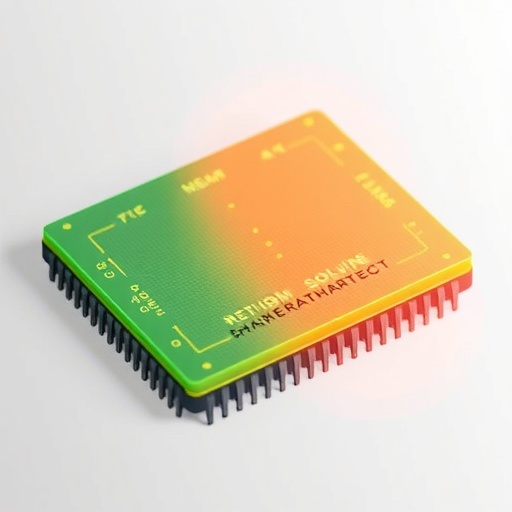In a remarkable technological advancement, researchers have successfully developed a high-precision and scalable analogue matrix equation solver utilizing resistive random-access memory (RRAM) chips. This breakthrough represents a significant stride towards more efficient computing methodologies, particularly in the realms of artificial intelligence and telecommunications. The solver operates on low-precision matrix functions, which align impressively well with RRAM-based computational frameworks, presenting new opportunities for accelerated computation without sacrificing accuracy.
At the heart of this innovation is the integration of a foundry-crafted 40-nm 1T1R RRAM array that boasts a 3-bit resolution. This architecture is essential for performing fundamental matrix operations, which serve as cornerstones of various complex algorithms. The design’s low precision is strategically leveraged to facilitate speed and efficiency, making it ideally suited for high-performance applications that require quick turnaround times.
Bit-slicing techniques were employed to enhance precision, an essential factor in maintaining accuracy while executing computations at rapid speeds. This unique approach mitigates the risks associated with traditional analogue methods that often compromise on precision for the sake of speed. The innovation lies in the synergy of bit-slicing, which disperses the data into multiple segments to ensure that each segment’s precision is maintained, culminating in a high-quality output despite the underlying low-precision computations.
Scalability is a crucial element of this new analogue solver, effectively addressed through the implementation of the BlockAMC algorithm. This technique allows for the handling of larger matrices without the exponential increase in computational demand that would typically accompany such scaling efforts. The experimental evidence is compelling: a 16×16 matrix inversion problem was tackled utilizing the BlockAMC algorithm with an impressive 24-bit fixed-point precision, thereby demonstrating the solver’s capability to efficiently manage larger computational tasks without sacrificing precision.
One of the fascinating applications of this analogue matrix equation solver lies in the domain of massive multiple-input multiple-output (MIMO) systems, which are pivotal in modern wireless communications. As the demand for faster and more reliable communication systems grows, so too does the need for efficient algorithms that can process vast data streams. The analogue solver successfully facilitated the detection process in such MIMO systems, revealing its potential to not only match but exceed the performance of traditional digital solutions.
In testing the efficacy of this approach, researchers discovered that the analogue solver could maintain identical bit error rate (BER) performance compared to its digital counterparts. This achievement was realized within a mere three iterative cycles for a configuration involving 128 transmitters and 8 receivers, using 256-QAM modulation. Such results underscore the solver’s operational efficiency and reliability, positioning it as a disruptive technology in the field of telecommunications.
The implications of this research extend beyond immediate applications, opening doors to future innovations in various fields. With the growing trend of miniaturization in technology, the ability to employ scalable analogue computing solutions can significantly alter the landscape of hardware design. By reducing the reliance on high-precision circuits, this innovation paves the way for the development of compact, energy-efficient devices capable of performing complex computations in real-world applications.
Moreover, the integration of RRAM technology with matrix operations suggests a promising direction for neuromorphic computing, where the processing paradigm mimics the neural structures of the brain. As researchers continue to seek ways to enhance computing capabilities in alignment with biological systems, the analogue solver exemplifies the type of cross-disciplinary innovation that can stimulate further advancements in both hardware and algorithmic design.
Furthermore, as the research community and industry stakeholders increasingly prioritize sustainability, the introduction of energy-efficient solutions like the analogue matrix equation solver aligns well with global efforts to develop greener technologies. This technology not only promises to reduce energy consumption compared to traditional high-precision computing platforms but also contributes to the longevity of computational hardware, thus promoting more sustainable practices in technology development.
As we look to the future, it becomes evident that the breakthroughs in scalable analogue matrix equation solving using RRAM chips may herald a new era in computational research. The continued exploration and refinement of this technology will likely yield further advancements, driving innovation across sectors including artificial intelligence, data science, and communications technology. Each step in this journey reflects the profound potential of analogue computing to reshape the ways we think about and utilize computational resources.
In conclusion, the development of a high-precision and scalable analogue matrix equation solver is a testament to the possibilities that reside at the intersection of hardware innovation and algorithmic advancement. As researchers continue to push these boundaries, the implications of these findings will undoubtedly resonate across industries, prompting a re-evaluation of how we approach computation in the digital age. The marriage of speed and precision may not just represent a technical achievement; it could very well be the key to unlocking the next generation of computing solutions.
With this new perspective on analogue computing, we are reminded of the limitless potential that arises from marrying innovative hardware with cutting-edge algorithms. The digital world is evolving, and with it, the methods we employ to interface with it. Innovations like the high-precision scalable analogue matrix equation solver serve as both a reflection of our current capabilities and a harbinger of the advancements to come.
Subject of Research: High-precision and scalable analogue matrix equation solving using RRAM technology.
Article Title: Precise and scalable analogue matrix equation solving using resistive random-access memory chips.
Article References:
Zuo, P., Wang, Q., Luo, Y. et al. Precise and scalable analogue matrix equation solving using resistive random-access memory chips.
Nat Electron (2025). https://doi.org/10.1038/s41928-025-01477-0
Image Credits: AI Generated.
DOI: 10.1038/s41928-025-01477-0
Keywords: RRAM, analogue matrix equation solver, high precision, scalability, BlockAMC algorithm, massive MIMO, telecommunications, energy-efficient computing, neuromorphic computing., digital counterparts.




